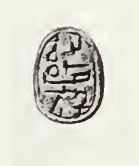| 'Ammu Aahotepre | |
|---|---|
 Scarab seal with the prenomen Aahotepre | |
| Pharaoh | |
| Reign | c. 15 years? 1760-1745 BC [1] |
| Predecessor | Qareh Khawoserre [2] |
| Successor | Sheshi Maaibre [2] |
| Dynasty | 14th Dynasty Second Intermediate Period |
'Ammu Aahotepre was a pharaoh of the 14th Dynasty who ruled over parts of Lower Egypt during the Second Intermediate Period. [5] [2]